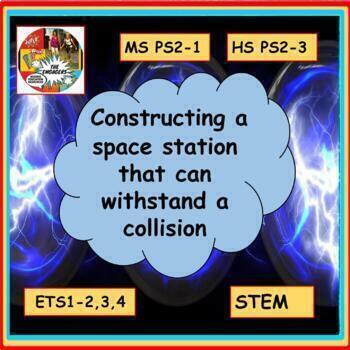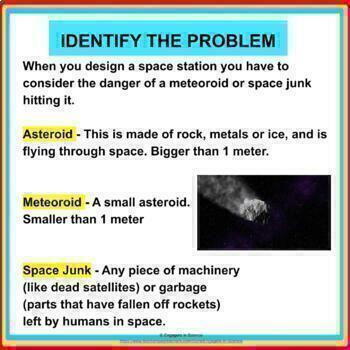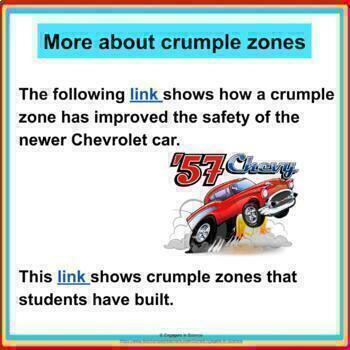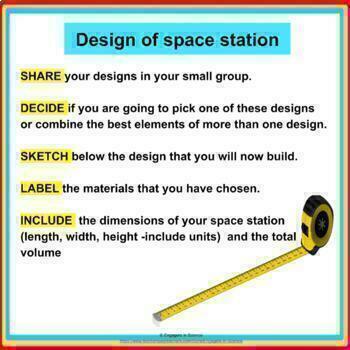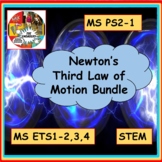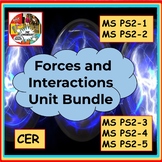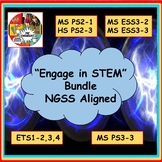CONSTRUCTING A SPACE STATION THAT WITHSTANDS A COLLISION: STEM MS-PS2-1 HS-PS2-3
- Google Drive™ folder

Also included in
- These two engaging lessons fully support the NGSS standard MS PS2-1: Apply Newton’s Third Law to design a solution to a problem involving the motion of two colliding objects.Lesson 1 - Investigation Newton's Third Law of MotionStudents move through five stations that guide them to “discover” Newton’Price $6.00Original Price $7.00Save $1.00
- This bundle includes everything you need to teach an NGSS aligned middle school force and motion unit. These highly engaging lessons align with the philosophy of the NGSS, including a focus on deeper understanding of content as well as application of content, student performance expectations, and inPrice $14.00Original Price $17.00Save $3.00
- This bundle includes everything you need to teach an NGSS aligned middle school forces and interactions unit. These highly engaging lessons align with the philosophy of the NGSS, including a focus on deeper understanding of content as well as application of content, student performance expectations,Price $23.00Original Price $29.00Save $6.00
- This bundle includes four engaging NGSS aligned STEM projects where students are challenged to use the engineering design process to construct an earthquake resistant building, a thermal solar panel, a space station that withstands a collision, and a solar oven. This bundle supports the NGSS standarPrice $13.00Original Price $16.00Save $3.00
Description
This highly engaging engineering and design project (GOOGLE and PDF versions) allows students to gain a greater understanding of why we need to build space stations that can withstand collisions.
The students first learn about crumple zones and why they are helpful in a collision.
Students design, construct, and test three crumple zones (made of simple materials) to see which is the best for attachment to their space station. A video showing student examples is included.
Students then design, construct, and test their space station (made of simple materials) to see if it will withstand a collision with a “baseball” meteoroid. The criteria for success is that the “egg” astronaut needs to be unharmed during the collision.
A written formative assessment is included which allows for students to critique their design and offer ideas for improvements. It also allows students the opportunity to connect this collision with Newton’s third law. Answers for this question are given and an activity is included to demonstrate how a collision exemplifies Newton’s Third Law.
Ideas are also given for easy implementation of this project such as team roles, accountability chart, schedule, a group contract and name.
This investigation can either be used to support student’s understanding of Newton’s Third Law or, alternatively, it could be used as an introduction to the law.
Easily obtainable materials are used for these activities (see list below).
The science and engineering practices below are incorporated in this investigation:
Analyzing and interpreting data
Constructing explanations and designing solutions.
Developing and using models.
Planning and carrying out investigations.
The cross cutting practices below are incorporated in this investigation:
System and system models
This project supports the NGSS standards MS PS2-1, MS ETS1-2, MS ETS1-3, MS ETS1-4, HS PS2-3
Included in this resource:
Teacher slides (18 slides)
Detailed teacher notes (12 pages)
Printable student worksheets with activity instructions (9 pages)
Sample answers for student assessment
Suggested materials needed for students (not all of these are necessary):
Tape, sponge, cardboard, packing material, shredded paper, straws, scrap material, aluminum foil, straws, paper, aluminum pie plates, string, card, corrugated cardboard, BBQ sticks, disposable cups, paper towel cardboard tubes, toilet paper cardboard tubes.
You may also like:
Investigating Newton's First Law of Motion MS PS2-2
Investigating Newton’s Second Law NGSS MS PS2-2 CER
Investigations into balanced and unbalanced forces MS PS2-2 CER
Investigating Newton's Third Law of Motion MS PS2-1
Earthquake resistant building STEM 5E project MS ESS3-2 MS ETS1-4
Climate Change STEM project Thermal Solar Panel MS PS3-3 MS ESS3-3 MS ETS1-2,3,4
Designing and constructing a solar oven STEM MS PS3-3 MS ETS1-2,3,4
Designing and constructing a medicine cooler STEM MS PS 1-6 MS ETS1-2,3,4
Investigating Potential Energy and Energy Transfer NGSS MS PS3-2 CER
A unit on gravitational forces MS PS2-4 CER
Investigating magnetic forces NGSS MS-PS2-3 MS-PS2-5 CER
Don't forget to give a review for this resource to earn TPT credits towards future purchases!
Also, FOLLOW US to be notified when new products are added!
Email any questions you have with subject line “Questions on space station stem project” to us at engagersinscience@gmail.com and we’ll be happy to answer them
Other teaching resources for sale in our Teachers Pay Teachers store can be accessed by using the link below:

